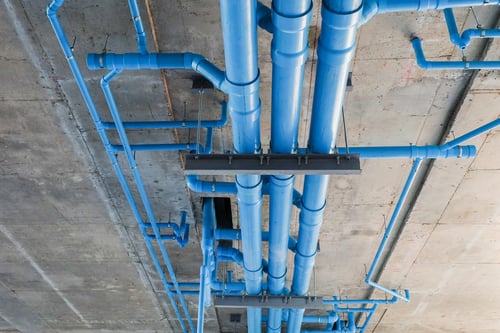Water-supply Design Engineers New York State
The Scope of Cold Water System Design Any cold water supply system comprises a myriad of pipes that deliver water to taps, appliances, firefighting equipment, and wherever else it is needed. The design itself must conform to accepted engineering practice as well as all relevant building and plumbing codes. Not only is it vital that there isn't flow between different piping systems (hot and cold water supply for instance), but the distribution system and pipes included in the system must also meet the criteria specified in the plumbing code. Water distribution system design criteria include pipe sizes that will cope with peak demand conditions and specified capacities. The minimum flow rate and flow pressure for appliances and fixtures must be in accordance with installation instructions provided by manufacturers. But it's not just the pipework that NYE and other MEP engineers have to work with during the design stage. A thorough understanding of everything from excavation and structural safety to the inclusion of fixtures and fittings is vital, depending of course on the type of building involved. Undoubtedly, good design begins with thorough planning and there is a constant need to ensure that the water infrastructure, supply requirements, and the capacity of the water system are all compatible. Demand is another vital factor that must be estimated before the water system is designed. This relates directly to the size and type of building including daily activities that take place in the building. Broadly speaking, these might be commercial, industrial, public, recreational, or domestic. There are various procedures for estimating water demand, one of which is provided in the UPC. MEP engineers also differentiate between total consumptive demand and the requirements relating to productivity. A vital element in terms of future productivity is inevitable distribution system leakage (DSL) that results from normal wear and tear. Also, while the design of cold water supply systems has its own specific demands, it is part of a much greater plumbing design required during the planning phase of any building. This, of course, includes hot water system design, vent piping design, hot water heater, hot water return system design, and of course sanitary system design. Often, kitchen, laundry, and bathroom design is also included in the overall plan. All these elements of MEP are included in our services. We ensure that the cold water system in your building operates properly with the correct pressure and flow rate, irrespective of the height of the building. Cold Water Pipes Both water service and water distribution pipes carry cold water, but water service pipes extend from the source of potable water to buildings while water distribution pipes are found inside buildings. All water service pipes must be the size that is suitable for the quantity of water that will be delivered as well as the pressure required in the relevant plumbing code. Generally, all water service pipes should be at least 1 inch or 25 mm in diameter. It stands to reason, that they have to be separate from sewers to prevent any possible contamination. Pipelines for cold water used for fire fighting (fire flow) must be at least 6 inches in diameter. MEP engineers take the distance between buildings into account when estimating the required fire flow. In New York, the installation of all new cold water service pipes must be done in accordance with the DEP regulations. MEP designers must also ensure that there is a meter installed in a position approved by the DEP, and the service pipe, house control valve, and this meter must be kept exposed at all times. If a homeowner or owner of a commercial or industrial building covers this over they will be in contravention of the regulations. There are always very strict regulations in terms of connections to the water mains of any city and these are supplied by the local authority. Owners of buildings pay for all costs. Fixture supply pipes (which are part of the water distribution network) must be specified in the water distribution system design in accordance with the minimum sizes allowed by the local authority. Minimum pipe sizes are specified for different fixtures (bathtubs, kitchen sinks, urinals, showers, WCs, and so on), as is the minimum flow rate and flow pressure required. So for instance, in the NYC Plumbing Code: Maximum flow rates and consumption are provided for a handful of plumbing and fixture fittings including lavatories, water closets (WC), sink faucets, and showerheads. These are all different from one another.
Water-supply Design Engineers New York State
Source: https://www.ny-engineers.com/mep-engineering-services/plumbing-services/cold-water-system-design
0 Response to "Water-supply Design Engineers New York State"
Post a Comment